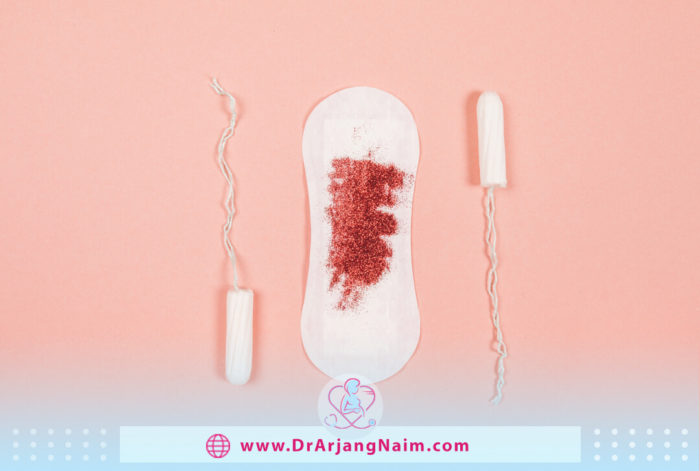Menometrorrhagia Definition
Menometrorrhagia is characterized by abnormal, heavy, prolonged, and irregular uterine bleeding. Women with this condition usually bleed more than 80 ml or 3 ounces during the menstrual cycle. Bleeding is unexpected and frequent. For example, bleeding may occur outside of menstruation.
It combines two conditions: menorrhagia, which is heavy bleeding during menstruation, and metrorrhagia when the menstrual period lasts more than seven days or spotting between menstrual periods. It is a common disease that affects between 10 and 30% of women of childbearing age.
Abnormal uterine bleeding is the most common menstrual disorder among postmenopausal women. This is not always a serious problem, but it can have serious underlying reasons, so it is important to see a doctor.
Menometrorrhagia Symptoms

Menstruation usually occurs every 28 days, although menstruation every 21 to 35 days is normal. The average length of a menstrual cycle is about five days. Most women will lose less than 80 milliliters or 3 ounces of blood. Most experts agree that any severe bleeding that disrupts physical, social, or emotional life is abnormal. Some signs of abnormal bleeding include:
- Bleeding longer than eight days
- Passing large blood clots
- Feeling tired, weak, or short of breath
- Bleeding outside the usual menstrual cycle
- Having back and abdominal pain during menstruation
- Soaking through sanitary pads or tampons every hour for several hours
What Causes Menometrorrhagia?
The causes of menometrorrhagia are not well understood, but some factors may cause it. Common menometrorrhagia causes are as follows:
Uterine Growths
Tumors such as uterine polyps and uterine fibroids can cause excessive bleeding due to the pressure they put on the uterus and the blood vessels in these lumps. These types of tumors are usually benign or noncancerous.
Hormonal Imbalance
Excessive female estrogen can cause the uterus lining to become thicker than expected. When a thicker coating begins to shed, blood loss and clotting can increase. Estrogen imbalance can occur for various reasons, including stress and obesity.
Adenomyosis
In adenomyosis, the uterus lining invades the uterus’s muscle wall and grows there. In such cases, the lining acts like the lining of the uterus, growing and shedding every month so that it can cause severe bleeding. The cause of adenomyosis is not well understood but is more common in postmenopausal women.
Endometriosis

Endometriosis occurs when the uterus lining grows outside the uterus, usually in the fallopian tubes (ovaries), ovaries, and pelvis. Bleeding can occur severely when this lining sheds.
Lack of Ovulation
Ovulation means the release of an egg from the ovary. If ovulation does not occur or the ovulation cycle is disrupted, the uterus lining can continue to grow until it has to shed.
Blood Clotting Disorders
Bleeding becomes longer when the blood cannot clot properly.
Other conditions include:
- Ectopic pregnancy: An ectopic pregnancy is when a fertilized egg grows outside a woman’s uterus elsewhere in her abdomen.
- Miscarriage: It is the loss of a baby before the twentieth week of pregnancy.
- Vaginal atrophy: Vaginal atrophy is when the walls of the vagina become thin, dry, and inflamed.
- Hypothyroidism: Hypothyroidism is a common disorder. In this case, the thyroid gland does not make enough thyroid hormone.
- Hyperthyroidism: Hyperthyroidism is when the butterfly-shaped thyroid gland in the lower neck, just above the collarbone, overproduces a hormone called thyroxine.
- Stopping or changing hormonal birth control or therapy
- Endometrial cancer: The uterus is covered with a special endometrium tissue. When cancer grows in this lining, it is called endometrial cancer.
- Vaginal cancer: Vaginal cancer occurs when cancer cells grow in the vagina.
- Ovarian cancer: Ovarian cancer is a type of cancer that starts in the ovaries.
- Cervical cancer: Cervical cancer occurs when cells in a woman’s cervix change, connecting the vagina and uterus.
- Pelvic inflammatory disease (PID): Pelvic inflammatory disease (PID) is an infection of the female genital organs. They include the uterus, ovaries, fallopian tubes, and cervix. It is usually caused by a sexually transmitted infection such as gonorrhea or chlamydia.
- Cervicitis: Cervicitis is inflammation of the cervix. It can be caused by several factors, including infection, chemical or physical irritations, and allergies.
- Vaginitis: Vaginitis is an inflammation of the vagina caused by an imbalance of yeasts and bacteria that normally live in the vagina.
How Common is Menometrorrhagia?
Approximately 11.4 to 13.2 percent of women have the disorder. Menometrorrhagia is more common in women 40 years and older, with an estimated 24% of women in their 40s and 50s experiencing the condition.
Menometrorrhagia Complications
Excessive menstrual bleeding can significantly impact health and quality of life. Significant blood loss can lead to anemia. Anemia is a condition in which the blood lacks oxygen-carrying red blood cells. Without oxygen-rich blood, you may feel weak and tired. Excessive menstrual bleeding can also be a sign of some reproductive cancers and conditions that affect fertility. It is essential to seek medical attention when you experience excessive bleeding.
Menometrorrhagia Diagnosis

The doctor will test for abnormalities that can cause Menometrorrhagia. For example, a blood test is used to test for pregnancy. Because miscarriage occurs, even when a person does not realize they are pregnant, it can cause severe bleeding. A pregnancy test can still be positive up to 35 days after the miscarriage.
The doctor will use a Pap smear to diagnose cervical cancer. The doctor may also do a hysteroscopy. This test can help the doctor diagnose conditions such as endometriosis. Other tests may include ultrasound and MRI.
Menometrorrhagia Treatment
Treatment of menometrorrhagia depends on the cause of the bleeding and whether the woman wants to become pregnant in the future. If another disease causes menometrorrhagia, it must be appropriately diagnosed and treated. Appropriate treatment may need to be selected with several healthcare providers working together.
Nonsteroidal Anti-inflammatory Drugs (NSAIDs)
Medications such as naproxen, sodium or ibuprofen help reduce blood loss during menstruation. They can also help treat painful cramps.
Birth Control Pills
Oral contraceptives can help regulate the menstrual cycle and reduce heavy or prolonged bleeding.
Progesterone
This hormone may be used to correct hormonal imbalances and reduce heavy bleeding.
Hormonal intrauterine device (IUD)
IUDs release a type of progesterone called levonorgestrel. This makes the uterus wall thinner and reduces menstrual blood flow and cramping.
Stopping or Changing Hormonal Medicine
If the hormone medication causes abnormal uterine bleeding, the doctor may change or stop the hormone treatment.
Iron Supplementation

If a woman has anaemia or low iron levels, her doctor may advise taking iron supplements.
Some causes of menometrorrhagia are best treated with surgery. Depending on the underlying cause, surgical options may include the following:
- Uterine fibroid embolization: This surgery removes the fibroids by cutting off the blood supply. Tiny particles enter the uterine arteries, which causes the fibroids to shrink.
- Myomectomy: This surgery removes the fibroids but keeps the uterus intact. After this procedure, women can still get pregnant naturally.
- Uterine ablation: Uterine ablation may be the best option for women who do not want to become pregnant in the future. In this surgery, the lining of the uterus is removed. This can be done with laser, heat, electricity, microwave energy, or freezing.
- Hysterectomy: If hormone therapy fails to control abnormal uterine bleeding, the doctor may recommend removing the uterus as a last resort. If cancer is the cause of Menometrorrhagia, a hysterectomy may also be needed, which is done with radiation or chemotherapy.
Menometrorrhagia vs. Menorrhagia
Menometrorrhagia is a general term for two different conditions that are almost identical.
Menorrhagia
Menorrhagia is a medical term for menstrual periods with severe or prolonged abnormal bleeding. Although heavy menstrual bleeding is a common concern, most women do not experience blood loss so severe that it can be defined as menorrhagia.
Metrorrhagia
Metrorrhagia, commonly referred to as menstrual bleeding, is vaginal bleeding that occurs at irregular intervals that are not related to the menstrual cycle. While blood comes out of the uterus like a menstrual period, bleeding does not indicate a normal period. There are several causes of metrorrhagia, some of which are harmless. In other cases, metrorrhagia can be a sign of a more serious illness.
The Bottom Line
Menometrorrhagia, also called excessive menstrual bleeding, abnormal vaginal bleeding, or dysfunctional uterine bleeding is vaginal bleeding that occurs when a person is not menstruating. Bleeding sometimes occurs due to lifestyle factors such as stress, weight loss, or travel, but it can also be due to hormonal changes, medications, and some health conditions. This type of bleeding can have many causes, some more serious than others. The type of treatment depends on the specific cause and needs of the person experiencing the surgery.
A gynecologist specializing in women’s reproductive health can help diagnose Menometrorrhagia and recommend effective treatment. Some of the underlying causes can affect fertility, but many women can become pregnant and give birth successfully after treatment.
Arjang Naim, MD examines the cause of abnormal and excessive bleeding with various examinations and tests and suggests the best treatment strategies.
Additional questions
1. Is Menometrorrhagia Dangerous?
Heavy periods are not usually life-threatening, but they can be dangerous if you lose too much blood. Bleeding through two or more tampons or pads every hour for two consecutive hours is a sign that you should see a doctor immediately or seek emergency care.
2. What are the symptoms of the pelvic inflammatory disease?
- Pain during sex
- Fever, sometimes with chills
- Painful, frequent, or difficult urination
- Unusual or heavy vaginal discharge
- Pain in your lower abdomen and pelvis
- Unusual or heavy vaginal discharge
3. Can Menometrorrhagia cause infertility?
Menorrhagia may be associated with infertility in the following conditions: Hysterectomy (removal of the uterus), Menorrhagia due to cancer. Adenomyosis (because it is located under the uterus wall but does not allow the fetus to implant in the uterus wall).
4. What is metrorrhagia Polymenorrhagia?
These include metrorrhagia (flow at irregular intervals), menometrorrhagia (frequent and excessive flow), polymenorrhea (bleeding at intervals of less than 21 days), and dysfunctional uterine bleeding (abnormal uterine bleeding without any obvious structural or systemic abnormalities).
5. Can stress cause vaginal bleeding?
Stress can cause various changes in the body, including menstrual cycle fluctuations. Some people may experience vaginal spotting due to high physical or emotional stress levels.
Sources:
https://www.webmd.com/baby/pregnancy-ectopic-pregnancy#1
https://www.webmd.com/cancer/understanding-endometrial-cancer-basics
https://www.webmd.com/women/guide/what-is-pelvic-inflammatory-disease
https://www.webmd.com/women/what-is-menometrorrhagia
https://www.mayoclinic.org/diseases-conditions/pelvic-inflammatory-disease/symptoms-causes/
https://www.mayoclinic.org/diseases-conditions/menorrhagia/symptoms-causes/syc-20352829
https://www.verywellhealth.com/an-overview-of-metrorrhagia-4584380




